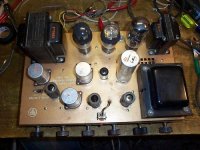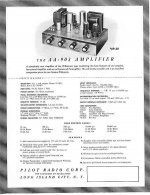hello all,
well they are not bogens, they are pilotones (AA-903). i've had one for a few years and managed to recently snag its evil twin on e-bay in non-working condition (hence this thread concerning its restoration). So, now I have stereo.
on e-bay in non-working condition (hence this thread concerning its restoration). So, now I have stereo.
they do look quite similar to bogen's however, ... perhaps the gold tone finish was the "in-thing" in the 50s.
circuit: push pull williamson good for about 10W or so. quite large transformers.
sound: great midrange, crisp highs, lively dynamics. this is NOT a laid-back tube amp, although i suspect the pre-amp section has something to do with that, as when i connected an outboard pre-amp to the 6v6GT power tubes, the sound mellowed somewhat. i've had great bass with these before, depending on speaker placement (i previously had the setup running mono in the corner of my dining room leading to bass re-inforcement, although maybe a bit uncontrolled) , ..but right now, there isn't that much bass with the same speakers (a pair of PSB 400i bookshleves of 89dB effeciency)setup in my living room. perhaps the speakers have something to do with that. i think pilot / pilotone amps are somewhat underrated on e-bay or elsewhere.
bottom line, i hardy ever listen to SS anymore, except when i desire bass slam.
well they are not bogens, they are pilotones (AA-903). i've had one for a few years and managed to recently snag its evil twin
 on e-bay in non-working condition (hence this thread concerning its restoration). So, now I have stereo.
on e-bay in non-working condition (hence this thread concerning its restoration). So, now I have stereo.they do look quite similar to bogen's however, ... perhaps the gold tone finish was the "in-thing" in the 50s.
circuit: push pull williamson good for about 10W or so. quite large transformers.
sound: great midrange, crisp highs, lively dynamics. this is NOT a laid-back tube amp, although i suspect the pre-amp section has something to do with that, as when i connected an outboard pre-amp to the 6v6GT power tubes, the sound mellowed somewhat. i've had great bass with these before, depending on speaker placement (i previously had the setup running mono in the corner of my dining room leading to bass re-inforcement, although maybe a bit uncontrolled) , ..but right now, there isn't that much bass with the same speakers (a pair of PSB 400i bookshleves of 89dB effeciency)setup in my living room. perhaps the speakers have something to do with that. i think pilot / pilotone amps are somewhat underrated on e-bay or elsewhere.
bottom line, i hardy ever listen to SS anymore, except when i desire bass slam.
The tone control network does not appear on the schematic, but I suspect it is a passive type - minor alterations to the caps values in the network will give you the relative mixture of bass and treble you want to match your speakers.
Interesting. I wonder why? I actually had such a thing happening to my perfect NOS power transformer.EC8010 said:
You haven't mentioned what sort of an HT rectifier your amplifier has. If it is a valve one, it won't like more than 47uF of capacitance. If it is selenium, then it's an explosion waiting to happen, and should be replaced before it takes out your mains transformer.
Probably the worst smell in the world....
From what I remember of seeing selinium recifiers go wrong (and I mean the multi-element air cooled ones with heat fins), this is what happens:
1 The resistance of one or more sections increases
2 The whole thing heats up
3 A nasty smell starts to be discharged
4 The poorest section gets hotter, and because of the increased voltage drop, sparks start to jump the selinium junction
5 Other sections get alternately high voltage or high current as the sparking occurs
6 Other sections fail eventually
I haven't experienced one completely short circuit, though it might happen. I guess it's the sparking that causes the transformer failure.
From what I remember of seeing selinium recifiers go wrong (and I mean the multi-element air cooled ones with heat fins), this is what happens:
1 The resistance of one or more sections increases
2 The whole thing heats up
3 A nasty smell starts to be discharged
4 The poorest section gets hotter, and because of the increased voltage drop, sparks start to jump the selinium junction
5 Other sections get alternately high voltage or high current as the sparking occurs
6 Other sections fail eventually
I haven't experienced one completely short circuit, though it might happen. I guess it's the sparking that causes the transformer failure.
twist head 90 degrees clockwise to view, ..this is the only reasonable way i could get diyaudio.com to accept an image of this shape factor
Tweaked in PhotoShop a bit, it fits now, so you don't have to turn your head sideways.
I have heard good things about the Pilot stuff -- haven't run into any yet thou.
dave
Attachments
- Status
- Not open for further replies.
- Home
- Amplifiers
- Tubes / Valves
- how do i figure out what's wrong with this (vintage) amp



